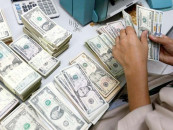Short of expectations: Unemployment surges as growth falls short of target
Economy grew by 3.2% compared to 4.2% target for this year.

Pakistan’s economy grew by 3.2%, which is much below the official target and the required growth rate, leaving at least 1.3 million people jobless this year.
“According to a provisional assessment, gross domestic product (GDP) grew by 3.2% in the financial year 2011-12 ending June 30,” said Sohail Ahmad, Secretary of Statistics Division, after chairing the 91st meeting of the National Accounts Committee, convened to finalise the growth figure.
Estimates are based on provisional information for eight to nine months, which is used for projection for the entire year.
This growth figure remains below the target of 4.2% and even less than the conservative estimates of the International Monetary Fund and the Asian Development Bank that put the growth at 3.6%.
The committee’s data shows that the major push came from commodity producing sectors – agriculture and industry – as the government missed its services growth target with a wide margin.
Net national income increased by Rs282.5 billion and, with the year’s population growth rate at 2.05%, per capita income rose by 1.3%.
“The growth rate is not enough to absorb two million people entering the job market every year,” said Dr Ashfaque Hasan Khan, Dean Business School of NUST. For creating jobs for the new entrants, a 7% to 8% growth was required, but due to the low rate 1.2 to 1.3 million young people remained unemployed this year.
Average growth for the last five years – covering all the period of Pakistan Peoples Party-led coalition government which came to power in March 2008 – stood at just 2.58%. In 2008, the economy grew by 2.2%, in 2009 2.8%, in 2010 1.8% and in 2011 3%, said Arif Cheema, Director General of Pakistan Bureau of Statistics.
Agriculture sector (24.7% of GDP)
The agricultural sector that pushed the overall growth rate up saw a robust growth due to improvement in soil fertility after floods for two years. Against the target of 3.4%, the sector grew by 3.6%.
Targets for major crops and forestry growth were surpassed. Compared to the target of 3%, major crops grew by 6.1% while forestry growth was 4.1% against the target of 2%.
However, production of minor crops dropped 2% against the target of 2% growth. Targets for wheat, sugarcane and rice production were also missed. Against the target of 25 million tons, wheat output was 23.5 million tons.
Rice production stood at 6.2 million tons compared to the target of 6.6 million tons while sugarcane harvest remained at 56.3 million tons against the target of 57.6 million tons.
Industrial sector (22.2% of GDP)
The industrial sector, which rose by 1.9% last year, expanded 3.6% this year because of growth in electricity, gas and water supply sub-sectors. The industrial growth target was 3.2%. Electricity and gas sectors grew by 15.5% against the target of just 1%. “We have added subsidies to the output of electricity generation, which is according to international norms,” said Arif Cheema.
Growth rate for mining and quarrying stood at 1.7% against the target of 1% while the manufacturing sector grew by 2.4% against the target of 3.7%. In the manufacturing sector, large-scale manufacturing rose by just 1.64% while the construction sub-sector, which last year contracted by around 1%, saw a growth of 2.8% this year.
Services sector (53.1% of GDP)
The government missed the services sector growth
target of 5% by a wide margin, as the biggest component of the economy rose by just 2.2% due to contraction in banking and financial sectors.
The finance and insurance sectors contracted by 11%, said Arif Cheema. The growth targets of all sub-sectors, except for ownership and dwellings, were missed.
The National Accounts Committee also revised last year’s growth upwards to 2.96% from the provisional 2.1%.
Published in The Express Tribune, April 27th, 2012.



















COMMENTS
Comments are moderated and generally will be posted if they are on-topic and not abusive.
For more information, please see our Comments FAQ